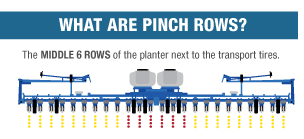It’s not news that planters today are bigger – much bigger – with more rows and attachments as well as higher seed and fertilizer capacity.
THE BENEFIT: Planting efficiency + time savings.
THE DRAWBACK: More weight going across the field, especially in pinch rows (the middle 6 rows of the planter next to the transport tires).
More weight can mean a less than ideal seedbed, and field compaction reduces yield by reducing oxygen and water to the plant roots and restricting root development. As recent plot tests by Farm Journal show, the impact on your bottom line can be considerable.

For example, say you’re planting 2,000 acres of corn with a 24-row bulk-fill planter. If 25 percent of total rows planted are pinch rows (the middle 6 rows) that means 25 percent of total acres planted (500) will be impacted. A 7-10 bushel decrease per acre at $4.00/bushel means a potential loss of $20,000.
In addition to potential yield loss, farmers must consider the long-term effects on soil profile and structure as the compacted zone will have to be dealt with the following year through tillage, cover crops or planter attachments.
THE SOLUTION: Some farmers choose to stay away from bulk-fill altogether. But those who want the benefits of bulk-fill and to limit the impact of pinch rows can turn to Kinze’s exclusive Hydraulic Weight Transfer system, which distributes planter weight evenly across the entire toolbar like a non bulk-fill planter.
On a standard bulk-fill planter, total weight of corn between pinch rows is about 6,000 lbs. On a Kinze bulk-fill planter with hydraulic weight transfer, it’s about 2,250 lbs. This gives you the benefits of bulk-fill while reducing yield loss due to pinch-row compaction.
Want to learn more? Check out this infographic on Pinch Row Compaction, or watch the video about the Kinze Hydraulic Weight Transfer system.
